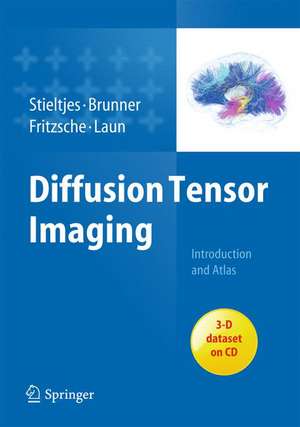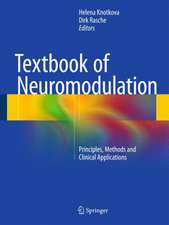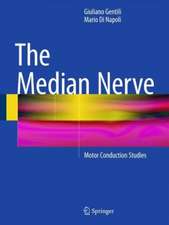Diffusion Tensor Imaging: Introduction and Atlas
Autor Bram Stieltjes, Romuald M. Brunner, Klaus Fritzsche, Frederik Launen Limba Engleză Mixed media product – 26 oct 2012
DTI offers a unique in-vivo insight into the three-dimensional structure of the human central nervous system. While easy interpretation and evaluation is often hampered by the complexity of both the technique and neuroanatomy, this atlas helps you recognize every one of the important structures rapidly and unambiguously.
In the introduction, this atlas provides a concise outline of the evolution of diffusion imaging and describes its potential applications. In the core part of the atlas, the neuroanatomically important structures are clearly labeled both on DTI-derived color maps and conventional MRI. Complex fiber architecture is illustrated schematically and described concisely in textboxes directly on the relevant page. In the final part of the atlas, a straightforward, step-by-step approach for the three-dimensional reconstruction of the most prominent fiber structures is given, and potential pitfalls are indicated.
The atlas aims at neuroscientists, neuroanatomists, neurologists, psychiatrists, clinical psychologists, physicists, and computer scientists. For advanced users, the atlas may serve as a reference work, while students and scientists are thoroughly introduced into DTI.
| Toate formatele și edițiile | Preț | Express |
|---|---|---|
| Paperback (1) | 1418.63 lei 38-44 zile | |
| Springer Berlin, Heidelberg – 4 mai 2017 | 1418.63 lei 38-44 zile | |
| Mixed media product (1) | 1446.82 lei 3-5 săpt. | |
| Springer Berlin, Heidelberg – 26 oct 2012 | 1446.82 lei 3-5 săpt. |
Preț: 1446.82 lei
Preț vechi: 1522.96 lei
-5% Nou
Puncte Express: 2170
Preț estimativ în valută:
276.88€ • 300.65$ • 232.58£
276.88€ • 300.65$ • 232.58£
Carte disponibilă
Livrare economică 01-15 aprilie
Preluare comenzi: 021 569.72.76
Specificații
ISBN-13: 9783642204555
ISBN-10: 3642204554
Pagini: 360
Ilustrații: VII, 380 p. With CD-ROM.
Dimensiuni: 210 x 279 x 27 mm
Greutate: 1.34 kg
Ediția:2012.
Editura: Springer Berlin, Heidelberg
Colecția Springer
Locul publicării:Berlin, Heidelberg, Germany
ISBN-10: 3642204554
Pagini: 360
Ilustrații: VII, 380 p. With CD-ROM.
Dimensiuni: 210 x 279 x 27 mm
Greutate: 1.34 kg
Ediția:2012.
Editura: Springer Berlin, Heidelberg
Colecția Springer
Locul publicării:Berlin, Heidelberg, Germany
Public țintă
Professional/practitionerCuprins
I Introduction:
0 How to Use this Atlas.- 1 Diffusion Imaging: Methods
II Atlas:
2 Two-dimensional Brain Slices.- 2.1 Coronal view.- 2.2 Sagittal view.- 2.3 Transversal view.- 3 Three-dimensional Fiber Tracking.- 3.1 Fiber tracking of the cerebral hemispheres.- 3.1.1 Fiber tracking of the corpus callosum.- 3.1.2 Fiber tracking of the cingulum.- 3.1.3 Fiber tracking of the fornix.- 3.1.4 Fiber tracking of the inferior longitudinal fasciculus.- 3.1.5 Fiber tracking of the inferior fronto-occipital and uncinate fasciculus.- 3.1.6 Fiber tracking of the superior longitudinal, the superior fronto-occipital and the arcuate fasciculus.- 3.1.7 Fiber tracking of the cerebral peduncles.- 3.2 Fiber tracking of the brain stem.- 3.2.1 Fiber tracking of the inferior cerebellar peduncle.- 3.2.3 Fiber tracking of the medial lemniscus and the superior cerebellarpeduncle
III Appendix: Index: Introduction.- Index: Atlas
0 How to Use this Atlas.- 1 Diffusion Imaging: Methods
II Atlas:
2 Two-dimensional Brain Slices.- 2.1 Coronal view.- 2.2 Sagittal view.- 2.3 Transversal view.- 3 Three-dimensional Fiber Tracking.- 3.1 Fiber tracking of the cerebral hemispheres.- 3.1.1 Fiber tracking of the corpus callosum.- 3.1.2 Fiber tracking of the cingulum.- 3.1.3 Fiber tracking of the fornix.- 3.1.4 Fiber tracking of the inferior longitudinal fasciculus.- 3.1.5 Fiber tracking of the inferior fronto-occipital and uncinate fasciculus.- 3.1.6 Fiber tracking of the superior longitudinal, the superior fronto-occipital and the arcuate fasciculus.- 3.1.7 Fiber tracking of the cerebral peduncles.- 3.2 Fiber tracking of the brain stem.- 3.2.1 Fiber tracking of the inferior cerebellar peduncle.- 3.2.3 Fiber tracking of the medial lemniscus and the superior cerebellarpeduncle
III Appendix: Index: Introduction.- Index: Atlas
Notă biografică
The editors have been working together as a team at the German cancer research center “DKFZ” in Heidelberg, Germany for a considerable time. Bram Stieltjes has been involved in the early development of DTI and in numerous clinical applications, e.g. in child psychiatry in cooperation with Romuald M. Brunner of Heidelberg University. Frederik Laun is an expert on the physical background of diffusion imaging. Klaus Fritzsche is currently working on software development for visualization and quantification of diffusion data.
Textul de pe ultima copertă
Diffusion Tensor Imaging (DTI) is a variation of diffusion-weighed imaging. Particularly in the neurosciences, this technique has gained tremendous momentum in the past decade, both from a technical point of view as well as in its applications. DTI is mainly used in neurological diagnosis and psychiatric and neurologic research, e.g. in order to locate brain tumors and depict their invasivity.
DTI offers a unique in-vivo insight into the three-dimensional structure of the human central nervous system. While easy interpretation and evaluation is often hampered by the complexity of both the technique and neuroanatomy, this atlas helps you recognize every one of the important structures rapidly and unambiguously.
In the introduction, this atlas provides a concise outline of the evolution of diffusion imaging and describes its potential applications. In the core part of the atlas, the neuroanatomically important structures are clearly labeled both on DTI-derived color maps and conventional MRI. Complex fiber architecture is illustrated schematically and described concisely in textboxes directly on the relevant page. In the final part of the atlas, a straightforward, step-by-step approach for the three-dimensional reconstruction of the most prominent fiber structures is given, and potential pitfalls are indicated.
The atlas aims at neuroscientists, neuroanatomists, neurologists, psychiatrists, clinical psychologists, physicists, and computer scientists. For advanced users, the atlas may serve as a reference work, while students and scientists are thoroughly introduced into DTI.
In the introduction, this atlas provides a concise outline of the evolution of diffusion imaging and describes its potential applications. In the core part of the atlas, the neuroanatomically important structures are clearly labeled both on DTI-derived color maps and conventional MRI. Complex fiber architecture is illustrated schematically and described concisely in textboxes directly on the relevant page. In the final part of the atlas, a straightforward, step-by-step approach for the three-dimensional reconstruction of the most prominent fiber structures is given, and potential pitfalls are indicated.
The atlas aims at neuroscientists, neuroanatomists, neurologists, psychiatrists, clinical psychologists, physicists, and computer scientists. For advanced users, the atlas may serve as a reference work, while students and scientists are thoroughly introduced into DTI.
Caracteristici
Direct comparison of DT-MRI and conventional MRT on opposing pages Nerve fibers visualized with great clarity – in vivo and three-dimensionally Concise overview and applications of Diffusion Tensor Imaging Fiber-tracking – how to reconstruct fibers Live pictures on CD









